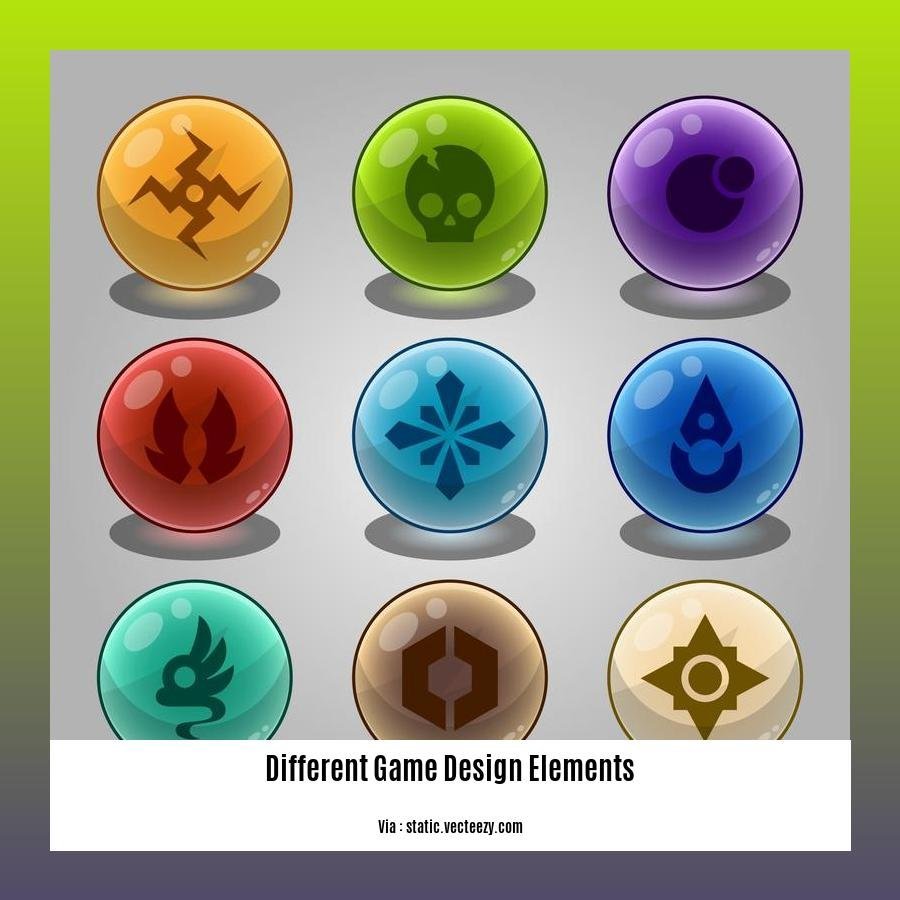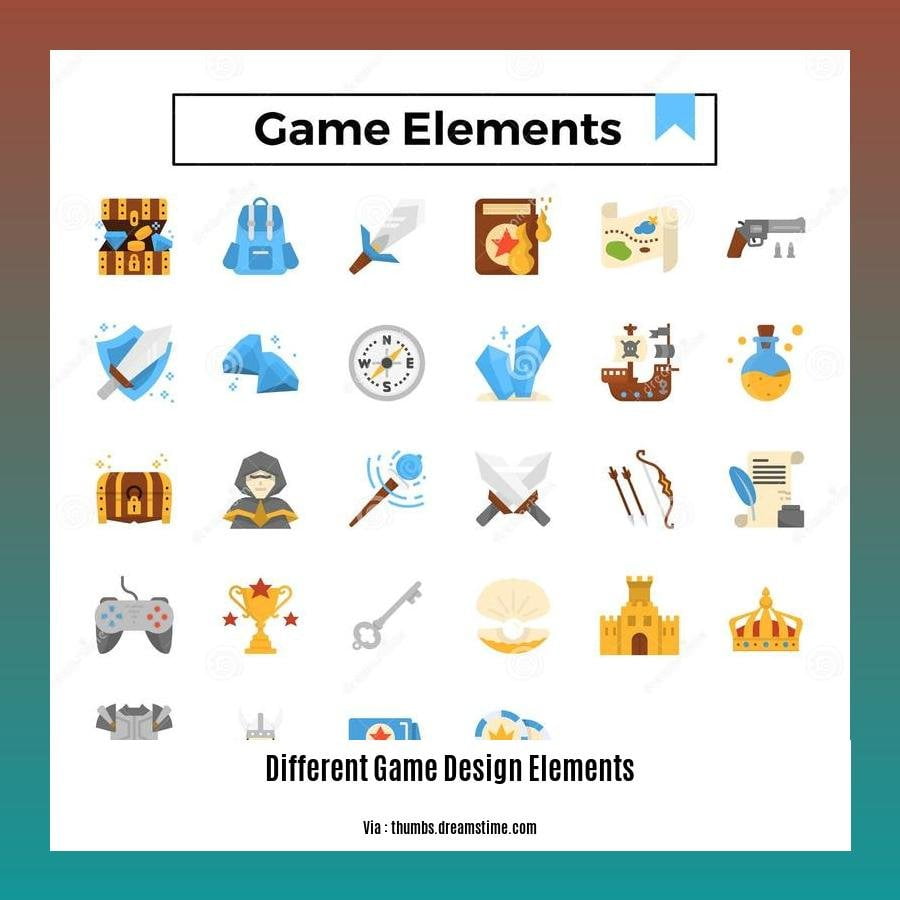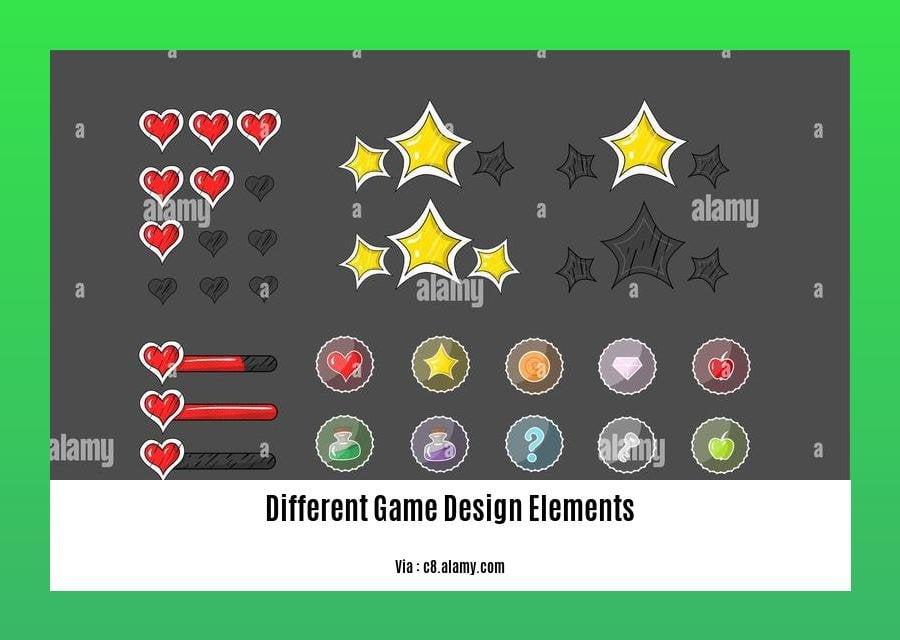In the symphony of game design, myriad elements intertwine, each playing a vital role in orchestrating an immersive and captivating experience. The Synergistic Dance of Different Game Design Elements: Crafting Immersive Gaming Experiences delves into the intricate interplay of level design, character development, and gameplay systems, exploring how they seamlessly converge to create virtual worlds that resonate with players.
Key Takeaways:
-
Essential Elements:
- Clear Objective
- Constraints
- Interactivity
- Surprise
- Strategy
-
Additional Elements:
- Runaway Leader Killer
- Inertia
- Aesthetics
- Storylines
- Characters
- Gameplay
-
Game designers carefully select and implement these elements to create engaging experiences.
-
Factors considered include player demographics, skill level, and game purpose.
-
Aim is to evoke emotions, challenge players, and provide satisfaction.
Different Game Design Elements

Games captivate us. There are different reasons for this.
They are immersive, provide challenges that entice us, and they can also be a great way to socialize.
So, what makes a great game? What are the ingredients that come together to create an unforgettable and immersive experience?
The answer lies in understanding and mastering the different game design elements that work together to orchestrate a cohesive and engaging experience.
Core Elements:
The foundation of any game lies in its core elements:
– Mechanics: The rules and systems that govern the game world and player interactions.
– Narrative: The story and characters that provide context and emotional depth to the gameplay.
– Level design: The physical and virtual environments that players navigate, impacting their choices and strategies.
– Aesthetics: The visual, auditory, and tactile elements that create the game’s atmosphere and ambiance.
– Player agency: The level of freedom and control players have over their actions and decisions, affecting their sense of empowerment and immersion.
Additional Considerations:
Beyond the core elements, game designers also consider:
- Runaway Leader Killer: Mechanisms to prevent one player from dominating the game, ensuring fairness and balance.
- Inertia: The resistance to change, influencing player momentum and decision-making.
- Aesthetics: The visual and auditory elements that enhance the game’s overall appeal and emotional impact.
- Storylines: The narrative threads that provide context and purpose to the gameplay experience.
- Characters: The individuals or entities that players interact with, shaping their emotional connection to the game.
- Gameplay: The core activities and challenges that define the game’s mechanics and player interactions.
The Art of Balance:
Mastering these elements is not just about including them but finding a harmonious balance that transforms the gameplay into a symphony of engagement. By carefully considering the interplay between these elements and aligning them with the game’s objectives, designers craft experiences that resonate with players on multiple levels.
So, next time you immerse yourself in a captivating game, take a moment to appreciate the intricate tapestry of different game design elements that weave together to create the magical experience you enjoy.
Did you know that the history of game design can be traced way back to ancient times? From the earliest board games like Senet and Go to the latest virtual reality experiences, game design has come a long way. So what are you waiting for? Click here to learn more about the history of game design.
Have you ever wondered who the early game designers were? From ancient game inventors like Senet and Liubo to modern game designers like Shigeru Miyamoto and Sid Meier, there have been many people who have made significant contributions to the field of game design.
Another interesting topic is the impact of technology on game design. The development of new technologies has had a major impact on the way games are designed and played. For example, the invention of the computer led to the creation of video games, and the development of the internet led to the creation of online games.
Level Design: The creation and arrangement of game environments to guide player progression and provide challenges

## Level Design: The Foundation of Immersive Gameplay
Level design is the art of crafting virtual worlds that guide players through a narrative, present challenges, and create memorable experiences. It encompasses everything from the physical environment to the placement of objects and enemies. Effective Level Design: The creation and arrangement of game environments to guide player progression and provide challenges is crucial for creating immersive and engaging gameplay.
### Key Principles of Level Design
- Player Progression: Levels should gradually introduce new challenges and obstacles, guiding players through the game’s narrative.
- Variety: Diverse environments and gameplay experiences keep players engaged and prevent monotony.
- Flow: Transitions between levels should be smooth and logical, enhancing the overall gameplay experience.
### Tools and Resources for Level Designers
- Unreal Engine 4: A powerful game engine offering customizable tools for level creation.
- Envato Tuts+: Beginner-friendly guides on level design.
- World of Level Design: Tips and techniques for aspiring level designers.
- Tactical Gamer Pro: Tutorial on map design in Unity.
## Key Takeaways:
- Level design is the process of creating and arranging game environments.
- Effective level design guides player progression and provides challenging experiences.
- Key principles include player progression, variety, and flow.
- Tools like Unreal Engine 4 and Envato Tuts+ help level designers create engaging levels.
## Citation
Aesthetics: The visual, audio, and sensory elements that enhance immersion and atmosphere
Aesthetics: The Sensory Symphony of Games
Aesthetics are the visual, audio, and sensory elements that envelop players in a game’s world. They’re the vibrant colors that dance across the screen, the haunting melodies that evoke emotions, and the tactile sensations that bring worlds to life.
Visuals are a feast for the eyes, shaping the player’s perception of their surroundings. From the sprawling vistas of Skyrim to the ethereal streets of Cyberpunk 2077, graphics immerse players in the game’s atmosphere and help them connect with the characters and story.
Audio is the symphony that accompanies every move, setting the tone and guiding the player’s emotions. The thunderous roar of a T-Rex in Horizon Zero Dawn can send shivers down the spine, while the soothing strains of a piano in Red Dead Redemption 2 paint a picture of solitude and loss.
Just as sound can evoke emotions, so too can physical sensations. Haptic feedback in racing games adds weight to the wheel, enhancing the thrill of the chase, while the rumble of a controller during an explosion intensifies the impact. These sensory cues create a tangible connection to the game world, making it more immersive and engaging.
Key Takeaways:
- Visuals: Captivating colors, textures, and lighting create striking environments.
- Audio: Sound effects and music set the mood, evoke emotions, and guide gameplay.
- Sensory Elements: Haptic feedback, vibration, and other sensations enhance immersion and bring worlds to life.
Citation:
Sensory Design in Games: Beyond Visual-Based Experiences
Player Agency: The extent to which players have control over their actions, decisions, and outcomes
In the realm of game design, player agency stands as a beacon of empowerment, granting players the reigns to shape their virtual destinies. This fundamental element empowers players to make meaningful choices, influencing the narrative and altering the course of their in-game experiences.
Key Takeaways:
- Control and Immersion: Player agency fosters a sense of control and immersion, enhancing engagement and making players feel like active participants in their gaming journey.
- Meaningful Decisions: It grants players the autonomy to make choices that impact the story, world, and ultimately, the outcome of their adventure.
- Diverse Manifestations: Player agency takes myriad forms, from character agency (controlling the protagonist’s actions) to plot agency (influencing the storyline) to world agency (transforming the game world).
- Motivation and Enjoyment: By giving players agency, designers tap into their intrinsic motivation and increase their enjoyment of the game.
- Effective Implementation: Game elements like mechanics, narrative, and choice systems can be strategically employed to provide players with meaningful and engaging agency.
Implementing Player Agency: A Delicate Balance
Striking the right balance in implementing player agency is paramount. Overbearing control can stifle creativity, while excessive freedom can lead to disorientation and frustration. Designers must carefully consider the game’s objectives and storyline to ensure that player agency aligns with the intended experience.
Examples of Player Agency in Action
- Fallout: Vast role-playing game where players control their character’s attributes, skills, and dialogue choices, shaping the narrative and affecting the game’s ending.
- The Sims: Life simulation game where players control every aspect of their Sims’ lives, from their daily routines to their relationships and aspirations.
- Grand Theft Auto V: Open-world action-adventure game offering players the freedom to explore a vast city, complete missions, and engage in a wide range of activities.
Conclusion
Player agency is a foundational pillar of game design, empowering players to be active participants in their interactive adventures. By providing players with meaningful choices and control over their actions, designers enhance immersion, motivation, and overall enjoyment. In the relentless pursuit of immersive and engaging gaming experiences, player agency remains an indispensable element, enabling players to leave their unique mark on the virtual worlds they inhabit.
Relevant Source:
FAQ
Q1: What are the key considerations when designing game levels?
A1: Level design involves creating environments, challenges, and experiences within a video game. Good level design enhances the player’s gameplay experience by ensuring player progression, providing variety, and maintaining a smooth flow.
Q2: How can sensory design enhance gaming experiences?
A2: Sensory design expands gaming experiences beyond visuals by incorporating elements like 3D and AR for immersive environments, vibration for tactile feedback, motion controls for physical engagement, and touch, voice, and blow interactions for intuitive controls.
Q3: What is player agency in games?
A3: Player agency refers to the degree of control and influence that players have over their actions and decisions within the game world. It encompasses the player’s ability to make choices, influence the game world, and see their decisions impact the game’s outcome.
Q4: How do game design elements contribute to player agency?
A4: Game design elements such as mechanics, narrative, and choice systems can be used to implement player agency effectively. By providing players with meaningful choices and shaping the game world based on their decisions, designers can empower players and enhance their immersion and engagement.
Q5: What are some examples of additional game design elements?
A5: Additional game design elements include runaway leader killer, inertia, aesthetics, storylines, characters, and gameplay. These elements work together to create well-rounded and engaging gaming experiences, evoking emotions, challenging players, and providing satisfying outcomes.
- Unveiling Bernhard Caesar Einstein’s Scientific Achievements: A Legacy in Engineering - July 15, 2025
- Uncover who is Jerry McSorley: CEO, Family Man, Business Success Story - July 15, 2025
- Discover Bernhard Caesar Einstein’s Scientific Contributions: Unveiling a Legacy Beyond Einstein - July 15, 2025















